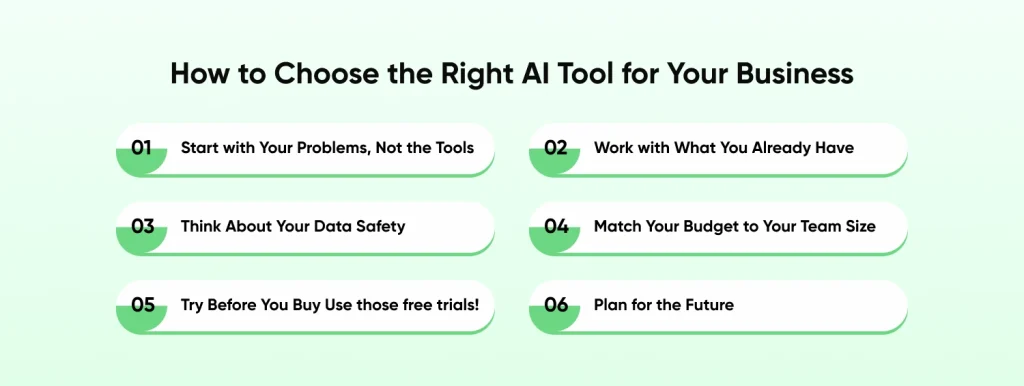Quick Summary: Are you struggling to find the best AI tool for your business? ChatGPT vs alternatives reveals that while ChatGPT is popular and easy to use, other AI tools excel at specialized tasks like content creation, research, coding, and productivity. The right choice depends on workflow, business needs, and data security.
Out of all the different use cases and integration of AI in everyday workflow, generative AI has seen the most widespread adoption and demand, with the global market estimated to soar to over $1 trillion by 2034. ChatGPT has played a significant role as a catalyst for revolutionizing generative AI capabilities, however there is a new wave of AI-powered business tools that have emerged, each with their own unique strengths, approach to language learning models, and key features.
The goal here is not to find one super solution that fits all requirements, but building a tailored stack of AI tools that align with specific goals, budgets, and requirements. Today we will be discussing different AI models that provide a ChatGPT better alternative for unique business needs, ranging from content creation to complex data analysis.
What is the Need For Exploring ChatGPT Similar Tools?
As we already mentioned, ChatGPT is an exceptional tool with widespread popularity, and many key capabilities. However, it requires special AI model fine-tuning development services to unlock its true potential. For businesses that cannot afford to build a specialized AI development team, this can be a significant limitation.
Points in Favour of ChatGPT
ChatGPT has become the default choice for many businesses exploring generative AI, and with good reason. Some of the major strengths include:
Widespread Adoption & Ecosystem
There are millions of active ChatGPT users that get access to an impressive ecosystem with community built AI agents that can be used for specific purposes. It also has an impressive set of third-party integrations.
Ease of Use
Off-the-shelf ChatGPT provides a welcoming and easy to navigate user experience with minimal setup. Its conversational interface can be understood easily by anyone with little to no technical expertise.
Rapid Prototyping
Businesses are able to easily test new ideas, automate customer interactions, or create content drafts without ever needing to build a custom AI model from scratch.
Constantly Evolving Features
The OpenAI community and developers are constantly pushing the boundaries of AI innovation and what’s possible. With each model, they work on enhanced reasoning, memory holding capabilities, plugins, and API improvements, so your business always stays ahead with the latest AI development trends.
Strong Language Understanding
ChatGPT has nailed natural language processing, making it useful for diverse applications like customer support, content creation, marketing copy, and knowledge management. You can assign any role to ChatGPT and get subpar to accurate results, depending on the expertise of the prompt engineer.
Limitations of ChatGPT
While ChatGPT is a powerful gen AI assistant, it has some clear limitations that we must understand before entirely relying on it:
Generalized Model
ChatGPT is not designed with a specific use case in mind. It is designed as a broad-use AI assistant that democratizes the use of GenAI for individuals, students, organizations and all possible stakeholders. Such a lack of specialization can lead to gaps in precision. Results produced for specific compliance, medical procedures and sensitive information might need to be fact-checked by a professional.
Limited Customization & Control
Compared to some ChatGPT alternatives, ChatGPT offers lesser flexibility in regards to aspects like model architecture, deployment environments, and data privacy configurations. You would need to hire AI developers with expertise in gen AI development to get the most out of ChatGPT.
Data Privacy Concerns
ChatGPT mainly runs in the cloud, which can make deployment and data control less flexible. Unlike some ChatGPT alternatives, it doesn’t offer many options for on-premises hosting, custom privacy settings, or industry-specific compliance. So if you are planning to create a website with ChatGPT, this is an important consideration.
Cost at Scale
While initial experimentation is affordable, large-scale deployments with high API usage can become expensive compared to self-hosted or open-source models.
ChatGPT vs Alternatives: Features, Use Cases, and Pros & Cons
Here are the top picks for ChatGPT vs other AI tools, compared on the basis of their core use case, key features, and what makes them ideal for your specific requirements.
| AI Tool | Main Focus Area | Description |
| Google Gemini | Best AI tools for Business Automation | Deeply integrates with Gmail, Docs, Sheets, and Slides. Handles text, images, and code with multimodal support. Ideal for automating tasks, research, and coding assistance. |
| Chatsonic | Real-Time Content and Trend AI | Real-time AI platform with live internet access, customizable personas, and multilingual support. Perfect for marketing, creative writing, and trend-driven content. |
| Claude | Long-Form Content and Thoughtful Conversation AI | Empathetic, human-like conversational AI. Handles large documents, brainstorming, research, and nuanced writing with strong memory retention. |
| Microsoft Copilot | Microsoft 365 Productivity AI | Built into Office 365 apps. Converts plain-language instructions into automated actions, drafts emails, reports, and presentations. Strong enterprise security. |
| Perplexity | Research and Fact-Checking AI | AI-powered search engine that cites sources. Ideal for academic writing, research, competitive intelligence, and transparent fact-checking. |
| Character.ai | Creativity and Entertainment AI | AI-driven personas and interactive conversations. Engaging for creative writing, gaming communities, role-playing, and social interaction. |
| GitHub Copilot | Developer Productivity and Coding AI | AI pair programmers integrated into IDEs. Autocompletes code, writes functions, and supports multiple programming languages. Boosts development efficiency. |
| Meta AI | Open-Source Customization and Experimentation AI | Open-source large language models (LLaMA). Highly customizable, suitable for self-hosted AI, research, and experimentation. |
| Grok | Social and Personality-Driven Interaction AI | Witty, edgy AI integrated with X (formerly Twitter). Ideal for conversational engagement, creative responses, and casual entertainment. |
1. Google Gemini – Best AI Tools for Business Automation
Gemini is Google’s flagship AI model, and a perfect AI chatbot for companies. The biggest advantage of Gemini is its deep integration across Google Workspace. If your team lives inside Gmail, Docs, Sheets, or Slides, Gemini feels like a natural extension of your workflow.
It also has a strong edge in multimodality, you can feed it text, images, and sometimes even code, and it interprets them with surprising accuracy. While it may not always feel as “chatty” as ChatGPT, Gemini is great when precision and Google’s vast data ecosystem matter most.
Key Features
- Deep integration with Gmail, Docs, Sheets, Slides, and NotebookLM
- Handles text, images, and code with multimodal support
- Advanced features like “Deep Research,” personalized “Gems,” and flash reasoning
- Ability to transform a blog into a web page, infographics, quiz and audio overview.
Use Cases
- Automating tasks inside Google Workspace
- Research, homework help, and visual creativity
- Coding assistance and AI agents
Pros
- Best choice if you live in the Google ecosystem
- Strong multimodal understanding
- Excellent research and productivity features
Cons
- Less appealing if you don’t rely on Google Workspace
- Premium features locked behind paid tiers

2. Chatsonic – Real-Time Content and Trend AI
Think of Chatsonic as ChatGPT’s younger, more adventurous cousin. It markets itself as a real-time AI platform. It boasts its ability to stay updated on the current events, trending topics, and information through integrations.
For businesses that need to be on the move and updated on latest trends, this can be a great ChatGPT alternative. Users can also create customizable personas, and tweak the assistant’s personality to match different use cases.
Key Features
- Real-time internet access for up-to-date answers
- Customizable personas and prompt library
- Image generation, voice features, and multilingual support
Use Cases
- Digital marketing content
- News publishing and trend-driven industries
- Creative writing and social media content
Pros
- Keeps answers fresh with live web search
- Flexible persona customization
- Multiple content formats supported
Cons
- Quality can be inconsistent compared to ChatGPT
- Interface less polished than other top tools
3. Claude – Long-Form Content and Thoughtful Conversation AI
Claude is built by Anthropic, and is hands-down one of the most “human” conversational AIs available. Its responses feel empathetic, calm, and contextually aware, almost like talking to a thoughtful colleague.
Where Claude shines is long-form content and memory retention; it can handle massive documents without losing track of the conversation. If ChatGPT feels like a brilliant problem-solver, Claude feels like a collaborator you trust to read, summarize, or brainstorm in a nuanced way.
Key Features
- Very large context window (up to 1 million tokens in enterprise)
- Strong memory and empathetic conversational style
- Constitutional AI framework for safety and ethics
- Ability to build custom artifacts
Use Cases
- Reading and summarizing long documents
- Research, analysis, and brainstorming
- Writing nuanced, thoughtful content
Pros
- Extremely good at handling long-form text
- Calm, “human-like” conversational tone
- Safe and reliable reasoning
Cons
- Fewer integrations than ChatGPT or Gemini
- Not as creative or witty as Grok
4. Microsoft Copilot- Microsoft 365 Productivity AI
If you’re part of the Microsoft ecosystem, Copilot is almost a no-brainer. It’s built directly into Office 365: Word, Excel, Outlook, and Teams, which means it saves hours of manual work. Imagine asking Excel to create a pivot table in plain English or having Outlook draft replies based on your style.
It’s heavily tied to Microsoft subscriptions and often feels more like a productivity booster for Microsoft-enabled teams rather than a free-form AI companion. But for enterprises, it’s one of the most practical tools on the list.
Key Features
- Built directly into Microsoft Office 365 apps like Word, Excel, Outlook, and Teams
- Converts plain-language instructions into automated actions (e.g., creating pivot tables, drafting emails)
- Provides AI-powered suggestions, summaries, and content generation within familiar Microsoft tools
- Ability to “create a new page” with Copilot assistant
- Strong enterprise security and compliance controls
Use Cases
- Automating routine tasks in Word, Excel, and Outlook
- Drafting emails, reports, and presentations quickly
- Enhancing team collaboration in Teams with AI-generated summaries and suggestions
- Boosting productivity for enterprises using Microsoft 365 workflows
Pros
- A must-have for Microsoft 365 users
- Saves time on routine office work
- Strong enterprise compliance
Cons
- Only available to Microsoft subscribers
- Feels more like a productivity booster than a conversational AI
5. Perplexity- Research and Fact-Checking AI
Perplexity is the search engine reimagined with AI. Unlike ChatGPT, which generates answers from what it has learned, Perplexity actively cites sources, giving you a transparent research experience. One of the biggest challenges with LLM models is ensuring that the answer is not a hallucination, and factually-backed.
Perplexity is ideal for researchers, analysts, or for teams that want reliable information treasure trove, with accurate and traceable answers over conversational flair.
Key Features
- AI-powered search engine which provides direct answers with source citations.
- Offers transparent research-style answers.
- Includes different search modes for the web, academic sources, and a “pro” mode for more in-depth queries.
Use Cases
- Excellent for research and fact-checking
- Ideal for academic writing and analysis
- Useful for competitive intelligence and market research
Pros
- Always cites its sources, which ensures transparency
- Highly reliable for research-driven work
- Makes it easy to verify the accuracy of the information it provides
Cons
- Not as conversational or creative as other AI models
- The free version has limited features
6. Character.ai – Creativity and Entertainment AI
This one is less about productivity and more about creativity and entertainment. Character.ai lets you interact with AI-driven personas—from historical figures to fictional characters or even custom-built personalities. It’s fun, quirky, and engaging, though not something you’d use for enterprise workflows.
Still, for gaming communities, social engagement, or even lightweight role-playing scenarios, it opens doors that ChatGPT was never really built for.
Key Features
- AI-driven personalities and role-play characters
- Custom characters and interactive conversations
- Voice and storytelling modes
Use Cases
- Entertainment and gaming communities
- Creative writing and role-playing
- Social engagement
Pros
- Fun and highly engaging
- Wide range of AI personas
- Strong Gen-Z appeal
Cons
- Not useful for productivity or enterprise work
- Safety concerns for younger users
7. GitHub Copilot- Developer Productivity and Coding AI
GitHub Copilot is one of the biggest assets to any development team. It integrates directly into your IDEs. It isn’t just a code-editor and suggestion tool, it can generate code snippets, functions, or even full-scaled modules based on natural language prompts. ChatGPT provides coding support too, however, Copilot is laser-focused on coding productivity, making it a more reliable and optimal AI tool for coding requirements.
It is not a flawless tool, you will still need to review and debug the codebase, but it surely can reduce development timelines and speed up the routine development work.
Key Features
- Acts as an AI “pair programmer” that plugs directly into your code editor
- Automatically completes your code, writes entire functions, and suggests ways to solve problems
- Supports a wide variety of programming languages
Use Cases
- Helps you write code much faster
- Assists with finding and fixing bugs
- A great way to learn new ways of coding and new programming patterns
Pros
- Gives a huge boost to a developer’s productivity
- Works seamlessly within the tools developers already use
- It is a cost-effective alternative to hiring a second developer for pair programming
Cons
- The code it generates is not always perfect and needs to be reviewed by a human
- The free version is limited
8. Meta AI – Open-Source Customization and Experimentation AI
Meta’s AI offerings are increasingly focused on open-source accessibility. LLaMA (their large language model) has gained traction because it can be fine-tuned and run in more flexible environments than ChatGPT. For tech teams that want to experiment, self-host, or deeply customize their AI, Meta’s open approach makes it appealing.
Meta AI is generally ideal for social media captions, and more low-level operations instead of writing detailed blogs or providing complete coding assistance.
Key Features
- Open-source large language models (8B–405B parameters)
- Highly customizable and fine-tunable
- Supports multimodal and research applications
Use Cases
- Perfect for building and deploying your own AI solutions from scratch
- Great for companies that want to experiment with custom AI models
- Ideal for startups and research teams that need full control and flexibility
Pros
- It’s free to use and the code is open for anyone to see and modify
- You can fine-tune and train it to fit your exact needs and even train it on your own data
- There’s a big and active community of developers who help each other out
Cons
- You need a good amount of technical know-how and computing power to set it up
- It might not be as smooth or easy to use as the AI tools you pay for
9. Grok – Social and Personality-Driven Interaction AI
Born out of Elon Musk’s x AI initiative, Grok is designed to be edgy, witty, and less restricted compared to traditional AI assistants. It is trained and fine-tuned on the rich database of X (Formerly Twitter), making its responses feel conversational and tuned to internet culture.
While it is still evolving, it is an ideal ChatGPT alternative for people who want something less formal, and more personality-driven.
Key Features
- Integrated within X (formerly Twitter)
- Witty, edgy personality compared to other AIs
- Latest version (Grok 4) handles reasoning, math, and image generation
Use Cases
- Conversational AI inside X platform
- Creative and witty responses
- Entertainment and casual engagement
Pros
- Fun, personality-driven tone
- Strong reasoning and creativity
- Integrated with X social features
Cons
- Still evolving; sometimes controversial
- Not business-focused
When to Choose Custom Generative AI Solutions over Market-Ready Solutions?

While the market is flooded with impressive off-the-shelf tools, some of the most innovative companies are going a step further by building custom generative AI solutions. This is where partnering with a specialized company becomes a game-changer. Rather than adapting your business to a tool, a custom solution adapts a tool to your business.
Outsourcing to a generative AI solutions company like CMARIX offers a strategic edge that off-the-shelf products can’t provide. Here’s how a custom AI software development company like us helps you stand out from the competition.
- Unmatched Specialization: A custom model can be fine-tuned on your company’s proprietary data—customer service transcripts, internal reports, technical manuals, or a specific brand voice. This creates an AI that understands your business with a depth and nuance that no public model can.
- Total Data Security and Compliance: For industries like healthcare or finance, data privacy is non-negotiable. A custom-built, in-house AI operates within your own secure environment, ensuring that sensitive information never leaves your control. A custom-built, in-house AI or AI MVP development services ensures that sensitive information stays secure.
- Seamless Integration with Your Workflow: Custom AI can be built to integrate directly into your internal platforms, ERP systems, and legacy software, eliminating the need for manual data transfer. This results in a truly streamlined and efficient workflow.
- Control and Ownership: You own the intellectual property and the model. This means you have full control over updates, maintenance, and future development, without being dependent on a third-party company’s roadmap or pricing changes.
- Diverse Team of AI Specialists: You get a team of developers with various specializations and knowledge of different AI programming languages like Python, .NET, Scala and much more.
- Cost-Effectiveness at Scale: While the initial investment might be higher, a custom solution can become far more cost-effective in the long run. By optimizing the model for your specific tasks, you can reduce per-token costs and increase efficiency, leading to a much higher ROI for a high-volume business.
How to Choose the Right AI Tool for Your Business
It’s easy to feel lost with so many AI tools, all saying they are the best. Picking the right one for your business doesn’t have to be hard. Here’s a simple guide to help.
1. Start with Your Problems, Not the Tools
What’s actually driving you crazy at work? Are you spending too much time writing content? Is customer support eating up your day? Talk to your team and figure out exactly what’s slowing you down before you even look at AI tools.
2. Work with What You Already Have
If your team already uses Microsoft Office, try Copilot first – it’ll work smoothly with everything you know. Using Google Workspace? Start with Gemini. Don’t make your life harder by picking something that doesn’t play nice with your current setup.
3. Think About Your Data Safety
Do you handle private customer info or secret business stuff? Then you need AI tools with serious security. Those free, public AI tools might not cut it if you’re dealing with sensitive information.
4. Match Your Budget to Your Team Size
Small team or working solo? Free tools like Perplexity might be perfect to start. Got a bigger company? Paying per person for something like Copilot might actually save you money in the long run.
5. Try Before You Buy Use those free trials!
Don’t just watch demos, actually use the tool for real work. Pick a specific task you do regularly and see if the AI actually makes it faster or better.
6. Plan for the Future
Think about where your business will be in a few years. If you anticipate needing highly specialized AI capabilities to stay ahead of competitors, it’s worth looking for a reliable AI software development company that can fine-tune an AI model or multiple models for your exact requirements.
Final Words
In conclusion, when evaluating ChatGPT vs alternatives, it is clear that no single AI tool fits every need. From this list of ChatGPT alternatives, the tools that best suit your project will be affected by various factors. By testing different tools and using trials, businesses can build a tailored AI stack that improves productivity, supports better decision-making, and drives long-term growth. Choosing the right AI tool ensures it integrates smoothly with operations and delivers real value to the team.
FAQs on ChatGPT vs Alternatives
Why Should Businesses Consider ChatGPT for AI Integration?
ChatGPT is a very reliable asset that can help with everything from writing content to answering customer questions, and you don’t need to be a tech expert to use it. Think of it as your all-in-one assistant, a “Swiss Army knife” for all sorts of business tasks. Because it’s so popular, chances are your team already knows how to use it, so you can all get started right away.
Which AI Chatbot Is Most Suitable for Customer Support?
It depends on your existing setup, if you’re using Microsoft tools, Copilot integrates seamlessly, while Google Workspace users should lean toward Gemini. For dedicated customer support, specialized platforms like Intercom or Zendesk’s AI features often work better than general-purpose chatbots. The best choice is the one that plugs directly into your current help desk system.
What Is the Future of AI Chat Solutions for Businesses?
AI chat solutions are moving toward hyper-personalization, where they’ll know your business context and customer history without you having to explain it every time. We’re heading toward AI that doesn’t just answer questions but proactively solves problems before customers even ask. Think less “chatbot” and more “digital team member who never sleeps.”
What Features Should Businesses Look for in an AI Solution?
Look for smooth integration with your existing tools, robust security for sensitive data, and the ability to learn your company’s specific language and processes. Don’t get dazzled by fancy features you’ll never use – focus on reliability, ease of training your team, and scalability as you grow. The best AI solution is the boring one that just works every single day.
Is There Any AI Better Than ChatGPT?
“Better” depends entirely on what you’re trying to accomplish – Claude excels at analysis and reasoning, while specialized tools like Jasper dominate content marketing, and Copilot wins for Microsoft-heavy workplaces. ChatGPT is like a reliable Honda Civic of AI – great all-around performance, but you might want a specialized sports car or truck depending on your specific needs. The real question isn’t what’s objectively better, but what works better for your particular use case.







